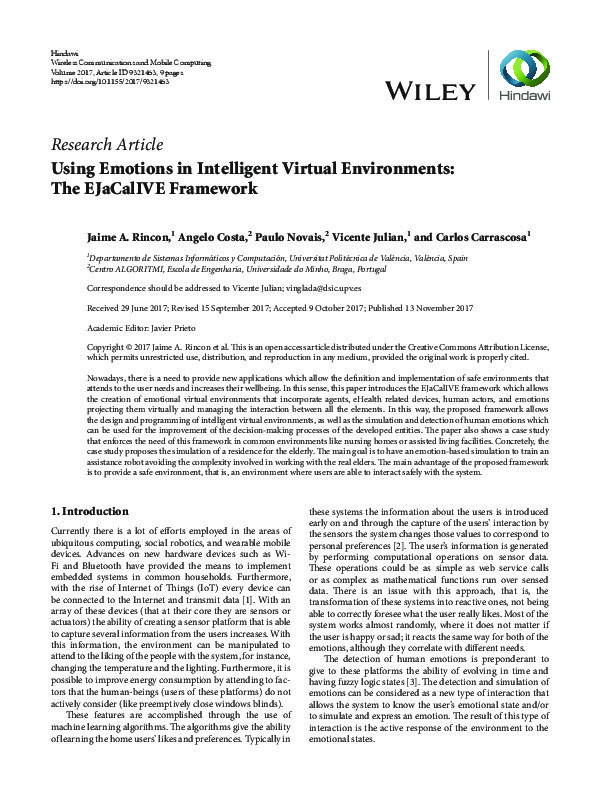Atzori, L., Iera, A., & Morabito, G. (2010). The Internet of Things: A survey. Computer Networks, 54(15), 2787-2805. doi:10.1016/j.comnet.2010.05.010
Perera, C., Zaslavsky, A., Christen, P., & Georgakopoulos, D. (2014). Context Aware Computing for The Internet of Things: A Survey. IEEE Communications Surveys & Tutorials, 16(1), 414-454. doi:10.1109/surv.2013.042313.00197
Kiosses, D. N., Gross, J. J., Banerjee, S., Duberstein, P. R., Putrino, D., & Alexopoulos, G. S. (2017). Negative Emotions and Suicidal Ideation during Psychosocial Treatments in Older Adults with Major Depression and Cognitive Impairment. The American Journal of Geriatric Psychiatry, 25(6), 620-629. doi:10.1016/j.jagp.2017.01.011
[+]
Atzori, L., Iera, A., & Morabito, G. (2010). The Internet of Things: A survey. Computer Networks, 54(15), 2787-2805. doi:10.1016/j.comnet.2010.05.010
Perera, C., Zaslavsky, A., Christen, P., & Georgakopoulos, D. (2014). Context Aware Computing for The Internet of Things: A Survey. IEEE Communications Surveys & Tutorials, 16(1), 414-454. doi:10.1109/surv.2013.042313.00197
Kiosses, D. N., Gross, J. J., Banerjee, S., Duberstein, P. R., Putrino, D., & Alexopoulos, G. S. (2017). Negative Emotions and Suicidal Ideation during Psychosocial Treatments in Older Adults with Major Depression and Cognitive Impairment. The American Journal of Geriatric Psychiatry, 25(6), 620-629. doi:10.1016/j.jagp.2017.01.011
Ciarrochi, J., Deane, F. P., & Anderson, S. (2002). Emotional intelligence moderates the relationship between stress and mental health. Personality and Individual Differences, 32(2), 197-209. doi:10.1016/s0191-8869(01)00012-5
Fong, T., Nourbakhsh, I., & Dautenhahn, K. (2003). A survey of socially interactive robots. Robotics and Autonomous Systems, 42(3-4), 143-166. doi:10.1016/s0921-8890(02)00372-x
RAMBOW, M., ROHRMÜLLER, F., KOURAKOS, O., BRŠCIC, D., WOLLHERR, D., HIRCHE, S., & BUSS, M. (2010). A Framework for Information Distribution, Task Execution and Decision Making in Multi-Robot Systems. IEICE Transactions on Information and Systems, E93-D(6), 1352-1360. doi:10.1587/transinf.e93.d.1352
Satyanarayanan, M. (2002). A catalyst for mobile and ubiquitous computing. IEEE Pervasive Computing, 1(1), 2-5. doi:10.1109/mprv.2002.993138
Han, D., & Lim, J. (2010). Smart home energy management system using IEEE 802.15.4 and zigbee. IEEE Transactions on Consumer Electronics, 56(3), 1403-1410. doi:10.1109/tce.2010.5606276
Intille, S. S. (2002). Designing a home of the future. IEEE Pervasive Computing, 1(2), 76-82. doi:10.1109/mprv.2002.1012340
Satyanarayanan, M. (2001). Pervasive computing: vision and challenges. IEEE Personal Communications, 8(4), 10-17. doi:10.1109/98.943998
Augusto, J. C. (2007). Ambient Intelligence: The Confluence of Ubiquitous/Pervasive Computing and Artificial Intelligence. Intelligent Computing Everywhere, 213-234. doi:10.1007/978-1-84628-943-9_11
Omicini, A., Ricci, A., & Viroli, M. (2008). Artifacts in the A&A meta-model for multi-agent systems. Autonomous Agents and Multi-Agent Systems, 17(3), 432-456. doi:10.1007/s10458-008-9053-x
Ricci, A., Viroli, M., & Omicini, A. (s. f.). CArtA gO: A Framework for Prototyping Artifact-Based Environments in MAS. Lecture Notes in Computer Science, 67-86. doi:10.1007/978-3-540-71103-2_4
Rincon, J. A., Poza-Lujan, J.-L., Julian, V., Posadas-Yagüe, J.-L., & Carrascosa, C. (2016). Extending MAM5 Meta-Model and JaCalIV E Framework to Integrate Smart Devices from Real Environments. PLOS ONE, 11(2), e0149665. doi:10.1371/journal.pone.0149665
Mehrabian, A. (1997). Analysis of Affiliation-Related Traits in Terms of the PAD Temperament Model. The Journal of Psychology, 131(1), 101-117. doi:10.1080/00223989709603508
Russell, J. A. (1980). A circumplex model of affect. Journal of Personality and Social Psychology, 39(6), 1161-1178. doi:10.1037/h0077714
Rincon, J. A., Costa, A., Novais, P., Julian, V., & Carrascosa, C. (2016). A Dynamic Emotional Model for Agent Societies. Lecture Notes in Computer Science, 169-182. doi:10.1007/978-3-319-39324-7_15
Rincon, J. A., Julian, V., & Carrascosa, C. (2015). Social Emotional Model. Lecture Notes in Computer Science, 199-210. doi:10.1007/978-3-319-18944-4_17
Huang, Y., Yao, H., Zhao, S., & Zhang, Y. (2015). Towards more efficient and flexible face image deblurring using robust salient face landmark detection. Multimedia Tools and Applications, 76(1), 123-142. doi:10.1007/s11042-015-3009-3
Rincon, J. A., Bajo, J., Fernandez, A., Julian, V., & Carrascosa, C. (2016). Using emotions for the development of human-agent societies. Frontiers of Information Technology & Electronic Engineering, 17(4), 325-337. doi:10.1631/fitee.1500343
Rincon, J. A., Costa, Â., Novais, P., Julian, V., & Carrascosa, C. (2016). Using Non-invasive Wearables for Detecting Emotions with Intelligent Agents. Advances in Intelligent Systems and Computing, 73-84. doi:10.1007/978-3-319-47364-2_8
Mehrabian, A. (1996). Analysis of the Big-five Personality Factors in Terms of the PAD Temperament Model. Australian Journal of Psychology, 48(2), 86-92. doi:10.1080/00049539608259510
[-]









